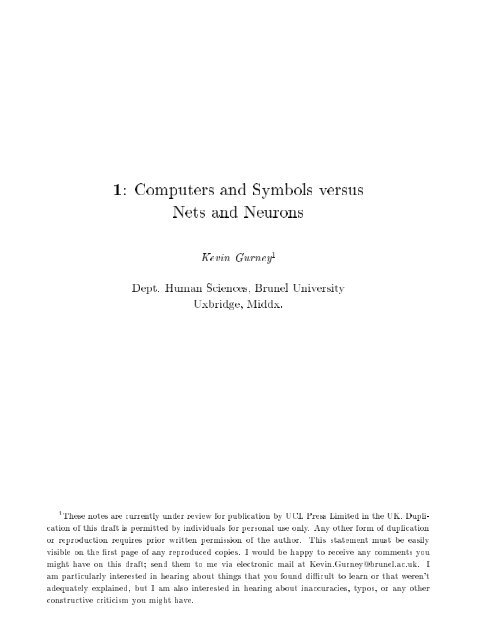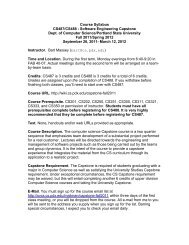1: Computers and Symbols versus Nets and Neurons - CiteSeerX
1: Computers and Symbols versus Nets and Neurons - CiteSeerX
1: Computers and Symbols versus Nets and Neurons - CiteSeerX
Create successful ePaper yourself
Turn your PDF publications into a flip-book with our unique Google optimized e-Paper software.
1: <strong>Computers</strong> <strong>and</strong> <strong>Symbols</strong> <strong>versus</strong><br />
<strong>Nets</strong> <strong>and</strong> <strong>Neurons</strong><br />
Kevin Gurney 1<br />
Dept. Human Sciences, Brunel University<br />
Uxbridge, Middx.<br />
1 These notes are currently under review for publication by UCL Press Limited in the UK. Duplication<br />
of this draft is permitted by individuals for personal use only. Any other form of duplication<br />
or reproduction requires prior written permission of the author. This statement must be easily<br />
visible on the rst page of any reproduced copies. I would be happy to receive any comments you<br />
might have on this draft; send them to me via electronic mail at Kevin.Gurney@brunel.ac.uk. I<br />
am particularly interested in hearing about things that you found dicult to learn or that weren't<br />
adequately explained, but I am also interested in hearing about inaccuracies, typos, or any other<br />
constructive criticism you might have.
Neural <strong>Nets</strong>: 1 1<br />
1 Neural net: A preliminary denition<br />
To set the scene it is useful to give a denition of what we mean by `Neural Net'. However,<br />
it is the object of the course to make clear the terms used in this denition <strong>and</strong> to exp<strong>and</strong><br />
considerably on its content.<br />
A Neural Network is an interconnected assembly of simple processing elements,<br />
units or nodes, whose functionality is loosely based on the animal neuron. The<br />
processing ability of the network is stored in the inter-unit connection strengths, or<br />
weights, obtained by a process of adaptation to, or learning from, a set of training<br />
patterns.<br />
In order to see how very dierent this is from the processing done by conventional<br />
computers it is worth examining the underlying principles that lie at the heart of all such<br />
machines.<br />
2 The von Neumann machine<br />
<strong>and</strong> the symbolic paradigm<br />
The operation of all conventional computers may be modelled in the following way<br />
central<br />
processing<br />
unit<br />
instructions<br />
<strong>and</strong> data<br />
data<br />
memory<br />
von-Neumann machine<br />
The computer repeatedly performs the following cycle of events<br />
1. fetch an instruction from memory.<br />
2. fetch any data required by the instruction from memory.<br />
3. execute the instruction (process the data).<br />
4. store results in memory.<br />
5. go back to step 1).
Neural <strong>Nets</strong>: 1 2<br />
What problems can this method solve easily It is possible to formalise many problems<br />
in terms of an algorithm, that is as a well dened procedure or recipe which will guarantee<br />
the answer. For example, the solution to a set of equations or the way to search for an item in<br />
a database. This algorithm may then be broken down into a set of simpler statements which<br />
can, in turn, be reduced eventually, to the instructions that the CPU executes.<br />
In particular, it is possible to process strings of symbols which obey the rules of some<br />
formal system <strong>and</strong> which are interpreted (by humans) as `ideas' or `concepts'. It was the<br />
hope of the AI programme that all knowledge could be formalised in such away: that is, it<br />
could be reduced to the manipulation of symbols according to rules <strong>and</strong> this manipulation<br />
implemented on a von Neumann machine (conventional computer).<br />
We may draw up a list of the essential characteristics of such machines for comparison<br />
with those of networks.<br />
The machine must be told in advance, <strong>and</strong> in great detail, the exact series of steps<br />
required to perform the algorithm. This series of steps is the computer program.<br />
The type of data it deals with has to be in a precise format - noisy data confuses the<br />
machine.<br />
The hardware is easily degraded - destroy a few key memory locations <strong>and</strong> the machine<br />
will stop functioning or `crash'.<br />
There is a clear correspondence between the semantic objects being dealt with (numbers,<br />
words, database entries etc) <strong>and</strong> the machine hardware. Each object can be `pointed<br />
to' in a block of computer memory.<br />
The success of the symbolic approach in AI depends directly on the consequences of<br />
the rst point above which assumes we can nd an algorithm to describe the solution to the<br />
problem. It turns out that many everyday tasks we take for granted are dicult to formalise<br />
in this way. For example, our visual (or aural) recognition of things in the world; how do<br />
we recognise h<strong>and</strong>written characters, the particular instances of which, we may never have<br />
seen before, or someone's face from an angle we have never encountered How dowe recall<br />
whole visual scenes on given some obscure verbal cue The techniques used in conventional<br />
databases are too impoverished to account for the wide diversity of associations we can make.<br />
The way out of these diculties that shall be explored in this course is that, by copying<br />
more closely the physical architecture of the brain, we mayemulate brain function more<br />
closely.
Neural <strong>Nets</strong>: 1 3<br />
3 Real neurons: a review<br />
efferent axon<br />
synapse*<br />
Dendrites<br />
cell body<br />
axon<br />
hillock<br />
Axon<br />
signals to other<br />
neurons<br />
Node of<br />
Ranvier<br />
myelin<br />
sheath<br />
* only one shown<br />
for clarity<br />
Biological neuron<br />
Signals are transmitted between neurons by electrical pulses (action-potentials or `spike'<br />
trains) travelling along the axon. These pulses impinge on the aerent neuron at terminals<br />
called synapses. These are found principally on a set of branching processes emerging from<br />
the cell body (soma) known as dendrites. Each pulse occurring at a synapse initiates the<br />
release of a small amount ofchemical substance or neurotransmitter which travels across the<br />
synaptic cleft <strong>and</strong> which is then received at post-synaptic receptor sites on the dendritic side<br />
of the synapse. The neurotransmitter becomes bound to molecular sites here which, in turn,<br />
initiates a change in the dendritic membrane potential. This post-synaptic-potential (PSP)<br />
change may serve to increase (hyperpolarise) or decrease (depolarise) the polarisation of the<br />
post-synaptic membrane. In the former case, the PSP tends to inhibit generation of pulses in<br />
the aerent neuron, while in the latter, it tends to excite the generation of pulses. The size<br />
<strong>and</strong> type of PSP produced will depend on factors such as the geometry of the synapse <strong>and</strong><br />
the type of neurotransmitter. Each PSP will travel along its dendrite <strong>and</strong> spread over the<br />
soma, eventually reaching the base of the axon (axon-hillock). The aerent neuron sums or<br />
integrates the eects of thous<strong>and</strong>s of such PSPs over its dendritic tree <strong>and</strong> over time. If the<br />
integrated potential at the axon-hillock exceeds a threshold, the cell `res' <strong>and</strong> generates an<br />
action potential or spike which starts to travel along its axon. This then initiates the whole<br />
sequence of events again in neurons contained in the eerent pathway.<br />
4 Articial neurons: the TLU<br />
The information processing performed in this way may be crudely summarised as follows:<br />
signals (action-potentials) appear at the unit's inputs (synapses). The eect (PSP) each signal<br />
has may be approximated by multiplying the signal by some number or weight to indicate<br />
the strength of the synapse. The weighted signals are now summed to produce an overall
Neural <strong>Nets</strong>: 1 4<br />
unit activation. If this activation exceeds a certain threshold the unit produces a an output<br />
response. This functionality is captured in the articial neuron known as the Threshold Logic<br />
Unit (TLU) originally proposed by McCulloch <strong>and</strong> Pitts (McCulloch <strong>and</strong> Pitts, 1943)<br />
x 1<br />
x 2<br />
x n<br />
w 1<br />
Σ<br />
w 2<br />
w n<br />
w i<br />
y<br />
θ<br />
a<br />
y<br />
multiplication<br />
by w i<br />
TLU<br />
We suppose there are n inputs with signals x1;x2;:::x n <strong>and</strong> weights w1;w2;:::w n . The<br />
signals take on the values `1' or `0' only. That is the signals are Boolean valued. (This allows<br />
their relation to digital logic circuits to be discussed). The activation a, isgiven by<br />
This may be represented more compactly as<br />
a = w1x1 + w2x2 + + w n x n (1)<br />
nX<br />
a = w i x i (2)<br />
i=1<br />
the output y is then given by thresholding the activation<br />
y =<br />
( 1 if a <br />
0 if a<<br />
(3)<br />
The threshold will often be zero. The threshold function is sometimes called a stepfunction<br />
or hard-limiter for obvious reasons. If we are to push the analogy with real neurons,<br />
the presence of an action-potential is denoted by binary `1' <strong>and</strong> its absence by binary `0'.<br />
Notice that there is no mention of time so far - the unit responds instantaneously to its<br />
input whereas real neurons integrate over time as well as space; how this may be this may be<br />
remedied will be discussed later.<br />
5 Non-binary signal communication<br />
The signals dealt with so far (for both real <strong>and</strong> articial neurons) take on only twovalues, that<br />
is they are binary signals. In the case of real neurons the two values are the action-potential
Neural <strong>Nets</strong>: 1 5<br />
voltage <strong>and</strong> the axon membrane resting potential. For the TLUs these were conveniently<br />
labelled `1' <strong>and</strong> `0' respectively. Now, it is generally accepted that, in real neurons, information<br />
is encoded in terms of the frequency of ring rather than merely the presence or absence of<br />
a pulse. (Phase information may also be important but the nature of this mechanism is less<br />
certain <strong>and</strong> will not be discussed here).<br />
There are two ways we can represent this in our articial neurons. First, we may extend<br />
the signal range to be positive real numbers. This works ne at the input straight away, but<br />
the use of a step function limits the output signals to be binary. This may beovercome by<br />
`softening' the step-function to a continuous `squashing' function<br />
1.0<br />
y<br />
0.5<br />
θ<br />
sigmoid<br />
a<br />
One convenient mathematical form for this is the sigmoid<br />
1<br />
y = (a) <br />
(4)<br />
1+e ,a=<br />
Here, determines the shape of the sigmoid: a larger value making the curve atter.<br />
In many texts, this parameter is omitted so that it is implicitly assigned the value 1. The<br />
activation is still given by eqn. (1) but now the output is given by (4). Units with this<br />
functionality are sometimes called semilinear units. The threshold now corresponds to the<br />
activation which gives y = 0.5. In (4) the threshold is zero <strong>and</strong> if we require a non-zero<br />
threshold then it must be included by writing<br />
1<br />
y = (a) <br />
(5)<br />
1+e ,(a,)=<br />
As an alternative to using real (continuous or analogue) signal values, we mayemulate<br />
the real neuron <strong>and</strong> encode a signal as the frequency of the occurrence of a `1' in a pulse<br />
stream.<br />
N time slots<br />
N 1 ‘1’s or pulses<br />
Probability of a ‘1’ or pulse approx. N 1<br />
N<br />
Pulse stream<br />
Time is divided into discrete `slots'. If the signal level we require is p, where 0 p 1,<br />
then the probability of a `1' appearing at each time slot will be p (If we require values in some<br />
other range then just normalise the signal rst to the unit interval). The output y, isnow<br />
/
Neural <strong>Nets</strong>: 1 6<br />
interpreted as the probability of outputting a `1' rather than directly as an analogue signal<br />
value. Such units are sometimes known as stochastic semilinear units. If we don't know p an<br />
estimate may be made by counting the number of `1's, N1, inN time slots. The probability<br />
estimate p is given by p = N1=N.<br />
In the stochastic case it is possible to reinterpret the sigmoid in a more direct way. First<br />
note that it is an approximation to the cumulative gaussian (normal distribution, cf z-scores<br />
in statistics). If we had, in fact used the latter then this is equivalent to modelling a `noisy'<br />
threshold; that is the threshold at any time is a r<strong>and</strong>om variable with gaussian (normal)<br />
distribution.<br />
P( θ)<br />
θ 0<br />
Normal distribution<br />
θ<br />
Thus, the probability of ring (outputting a `1') if the activation is a, is just the probability<br />
that the threshold is less than a, which is just the cumulative of the gaussian up to<br />
this value.<br />
6 Introducing time<br />
The articial neurons discussed so far all evaluate their activation <strong>and</strong> output `instantaneously'<br />
- there is no integration of signals over time. To introduce dependence on time, we dene<br />
the activation implicitly by its rate of change da=dt. This requires that the weighted sum of<br />
inputs be denoted by some other quantity. Thus, put<br />
<strong>and</strong> now put<br />
nX<br />
s = w i x i (6)<br />
i=1<br />
da<br />
= ,a + s (7)<br />
dt<br />
where <strong>and</strong> are positive constants. The rst term gives rise to activation decay, while<br />
the second represents input from the other neurons <strong>and</strong> may be excitatory. To see the eect<br />
of the decay term put s = 0. There are now two cases.<br />
i) a>0. Then da=dt < 0; that is, a decreases.<br />
ii) a 0; that is, a increases
Neural <strong>Nets</strong>: 1 7<br />
a<br />
a<br />
t<br />
Decay from<br />
positive values<br />
t<br />
Decay of activation<br />
Decay from<br />
negative values<br />
The neuron will reach equilibrium when da=dt = 0. That is when<br />
a = s<br />
(8)<br />
a<br />
There are several possible modications to (7). e.g., `PDP' vol 3 ch 2, <strong>and</strong> (von der<br />
Malsburg, 1973; Hopeld <strong>and</strong> Tank, 1986). Stephen Grossberg has made extensive use of this<br />
type of functionality - see for example (Grossberg, 1976).<br />
7 Network features<br />
Having looked at the component processors of articial neural nets, it is time to compare<br />
the features of such nets with the von Neumann paradigm. The validity of some of these<br />
properties should become clearer as the operation of specic nets is described.<br />
Clearly the style of processing is completely dierent - it is more akin to signal processing<br />
than symbol processing. The combining of signals <strong>and</strong> producing new ones is to be<br />
contrasted with the execution of instructions stored in a memory.<br />
Information is stored in a set of weights rather than a program. The weights are<br />
supposed to adapt when the net is shown examples from a training set.<br />
<strong>Nets</strong> are robust in the presence of noise: small changes in an input signal will not<br />
drastically aect a node's output.<br />
<strong>Nets</strong> are robust in the presence of hardware failure: a change in a weightmay only aect<br />
the output for a few of the possible input patterns.<br />
High level concepts will be represented as a pattern of activity across many nodes rather<br />
than as the contents of a small portion of computer memory.<br />
The net can deal with `unseen' patterns <strong>and</strong> generalise from the training set.<br />
<strong>Nets</strong> are good at `perceptual' tasks <strong>and</strong> associative recall. These are just the tasks that<br />
the symbolic approach has diculties with.
Neural <strong>Nets</strong>: 1 8<br />
References<br />
Grossberg, S. (1976). Adaptive pattern classication <strong>and</strong> universal recoding: 1. parallel<br />
development <strong>and</strong> coding of neural feature detectors. Biological Cybernetics, 23:121 { 134.<br />
Hopeld, J. J. <strong>and</strong> Tank, D. W. (1986). Computing with neural circuits: A model. Science,<br />
233:625 { 633.<br />
McCulloch, W. <strong>and</strong> Pitts, W. (1943). A logical calculus of the ideas immanent in nervous<br />
activity. Bulletin of Mathematical Biophysics, 7:115 { 133.<br />
von der Malsburg, C. (1973). Self-organisation of orientation sensitive cells in the striate<br />
cortex. Kybernetik, 14:85 { 100.




